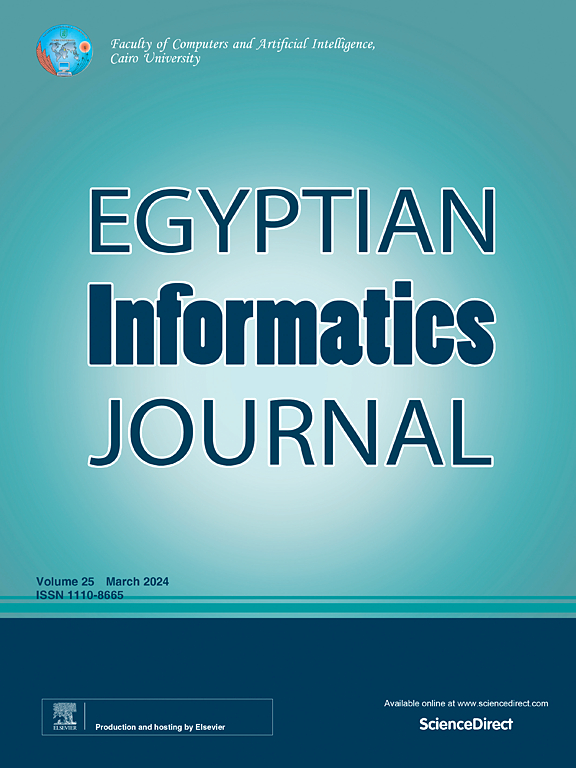Edge computing optimization: an enhanced algorithm for efficient caching and latency reduction
IF 4.3
3区 计算机科学
Q1 COMPUTER SCIENCE, ARTIFICIAL INTELLIGENCE
引用次数: 0
Abstract
Digital transformation in the healthcare sector has witnessed a tremendous change in the last few years, which has allowed health care professionals to access and remotely monitor patient status using connected devices. Although digital healthcare is more convenient to patients, saves time and is more cost-effective, it also creates a problem of latency as the processing and storage of data is done on centralized cloud servers. Edge Computing (EC) presents an exciting opportunity as it brings data processing too near the source, and is challenged by limited storage capacity and complex infrastructure. To solve these problems, simulation research is proposed in this paper, called Dove Swarm Optimization-based Edge Caching (DSOA-EC), which combines the edge caching mechanism and swarm intelligence to reduce the latency cost and enhance the Quality of Service (QoS). The DSOA-EC is unique by having an intelligent caching strategy that can dynamically pick the best data point according to set caching criteria and current network conditions. The architecture consists of three layers: device, edge and cloud, each optimized to support data processing and transmission efficiency within the constraints of operational environment. Simulation results demonstrate that the DSOA-EC model significantly outperforms conventional caching protocols, achieving a 92% cache hit rate, 0.22-second sensing delay, 99% data freshness, 0.0021-second data retrieval latency, and energy efficiency of 155 J. The performance demonstrates that the DSOA-EC successfully reduces the latency of buffers and improves the QoS. Here its potential as a scalable, real time edge computing solution to a health care environment is demonstrated. These findings provide strong proof-of-concept evidence, and establish a strong footing in large multi-center trials and real-world application.
边缘计算优化:用于高效缓存和减少延迟的增强算法
在过去几年中,医疗保健行业的数字化转型发生了巨大变化,这使得医疗保健专业人员能够使用连接的设备访问和远程监控患者的状态。尽管数字医疗对患者来说更方便、节省时间、更具成本效益,但由于数据的处理和存储是在集中式云服务器上完成的,因此也会产生延迟问题。边缘计算(EC)提供了一个令人兴奋的机会,因为它使数据处理过于接近源,并且受到有限的存储容量和复杂的基础设施的挑战。针对这些问题,本文提出了基于Dove Swarm optimization based Edge Caching (DSOA-EC)的仿真研究,将边缘缓存机制与群体智能相结合,以降低延迟成本,提高服务质量(QoS)。DSOA-EC的独特之处在于它具有智能缓存策略,可以根据设置的缓存标准和当前网络条件动态地选择最佳数据点。该架构由三层组成:设备层、边缘层和云层,每层都经过优化,以支持在操作环境约束下的数据处理和传输效率。仿真结果表明,DSOA-EC模型显著优于传统的缓存协议,实现了92%的缓存命中率、0.22秒的感知延迟、99%的数据新鲜度、0.0021秒的数据检索延迟和155 j的能量效率。性能表明,DSOA-EC模型成功地降低了缓冲区的延迟,提高了QoS。这里展示了其作为医疗保健环境中可扩展的实时边缘计算解决方案的潜力。这些发现提供了强有力的概念证明证据,并为大型多中心试验和实际应用奠定了坚实的基础。
本文章由计算机程序翻译,如有差异,请以英文原文为准。
求助全文
约1分钟内获得全文
求助全文
来源期刊

Egyptian Informatics Journal
Decision Sciences-Management Science and Operations Research
CiteScore
11.10
自引率
1.90%
发文量
59
审稿时长
110 days
期刊介绍:
The Egyptian Informatics Journal is published by the Faculty of Computers and Artificial Intelligence, Cairo University. This Journal provides a forum for the state-of-the-art research and development in the fields of computing, including computer sciences, information technologies, information systems, operations research and decision support. Innovative and not-previously-published work in subjects covered by the Journal is encouraged to be submitted, whether from academic, research or commercial sources.
 求助内容:
求助内容: 应助结果提醒方式:
应助结果提醒方式:


